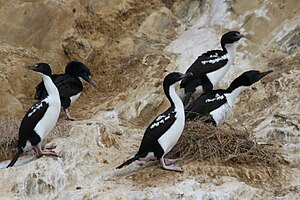Warthog
| Warthog | ||||||||||
|---|---|---|---|---|---|---|---|---|---|---|

Wart shag ( Leucocarbo carunculatus ) |
||||||||||
| Systematics | ||||||||||
|
||||||||||
| Scientific name | ||||||||||
| Leucocarbo carunculatus | ||||||||||
| ( Gmelin , 1789) |
The warthog ( Leucocarbo carunculatus , Syn . : Phalacrocorax carunculatus ), also known as the warty cormorant , is a species of cormorant that is endemic to some islands in the Cook Strait between the North and South Islands of New Zealand . The IUCN classifies the warthog as endangered ( vulnerable ) and estimates the population at fewer than 1000 sexually mature individuals. Overall, the population has been stable for 50 years and it is believed that the wart shag population has never been very high.
Appearance
The warthog reaches a size of up to 76 cm and a weight of 2.5 kilograms. In her appearance she is black and white. The head is black. The back of the neck, the back of the neck, the rump and the upper tail covers have a metallic blue shimmer. The underside is white and the feet pink. When the wings are folded, a white band can be seen as a color pattern. During the breeding season there are yellow-orange warts on the base of the beak. Otherwise the beak is gray-blue. The eyes are surrounded by a blue ring.
Within its range, the warthog can only be confused with the magpie . In this case, however, the face has more extensive white plumage and there is more white on the neck. Magpie shots also have black feet and legs. The warthog can also be distinguished from other species of cormorant by the fact that it does not build up and does not spread its wings to dry them.
distribution
The warthog breeds on the four rock islands White Rocks , Sentinel Rock , Duffers Reef and Trio Islands in the Marlborough Sounds on the Cook Strait . So far there have been no observations of this species of cormorant outside the Marlborough Sounds. Warthags look for their food within a radius of 24 kilometers around this small group of islands. The average surface temperature of the water around the islands is only 12 degrees Celsius, which indicates that sub-Antarctic currents predominate here.
Way of life
The main food of the warthog consists of Arnoglossus scapha , a left-eyed flounder that New Zealanders refer to as a "witch". This species of fish does not play a role in commercial fishing. They also eat small crustaceans. The food is mainly captured by diving, the individual dives take an average of 46.5 seconds. The longest observed dive lasted 95 seconds.
The reproductive biology of the warthog has not been very well studied. Warty shags are very shy during the breeding season, so any examination would have a negative effect on the breeding success of this species. It is believed that wart shags are birds that enter into a monogamous couple relationship that lasts for more than one breeding season. Both parent birds are involved in the brood and both look after the young birds.
Breeding birds are mainly observed between March and December, the peak of the breeding season begins in May, and egg-laying appears to be largely complete in August. The entire reproductive cycle takes five months, and it cannot be ruled out that in some breeding colonies birds will begin a second brood in less than twelve months. Wart shags are colony breeders. The breeding colonies comprise between two and 80 nests and are at least one meter apart. Only the immediate nest environment is defended by the parent birds. The clutch size consists of one to three eggs, two eggs seem to be the typical clutch size. Newly hatched chicks are initially naked.
Danger
In the 19th century the warthog was one of the species of bird that was hunted for feather fashion. Specimens were also shot to supply museums with bird skins. The effect that this form of hunting had on the total population cannot be estimated. One of the current threat factors today is primarily commercial fishing: In waters near the breeding colonies, large trawls and gill nets are used to fish in which wart shags looking for food can get caught. The region in which the breeding colonies are located is also increasingly being developed for tourism. Disturbance to breeding birds from passing boats, low-flying planes or divers can cause the breeding birds to leave their nests. The clutches in particular are endangered by seagulls. Occasionally, wart shags are also shot illegally.
All breeding colonies are now protected, boats have to keep a distance of at least 50 or 100 meters when passing by, but this distance may not be sufficient not to disturb the birds. The house rats that were briefly introduced to Duffers Reef were successfully eliminated there in 1983.
supporting documents
literature
- PJ Higgins (Eds.): Handbook of Australian, New Zealand & Antarctic Birds , Volume 1, Ratites to Ducks, Oxford University Press, Oxford 1990, ISBN 0-19-553068-3
Web links
- BirdLife International: Species Factsheet - New Zealand King Shag ( Phalacrocorax carunculatus )
- New Zealand Birds - Kingshag (Engl.)
- Possible impacts of marine farming of mussels (Perna canaliculus) on king shags (Leucocarbo carunculatus) Possible impacts of marine farming of mussels (Perna canaliculus) on king shags (Leucocarbo carunculatus) (Engl.)
- Videos, photos and sound recordings of Phalacrocorax carunculatus in the Internet Bird Collection
- Leucocarbo carunculatus inthe IUCN 2013 Red List of Threatened Species . Listed by: BirdLife International, 2012. Retrieved September 8, 2013.